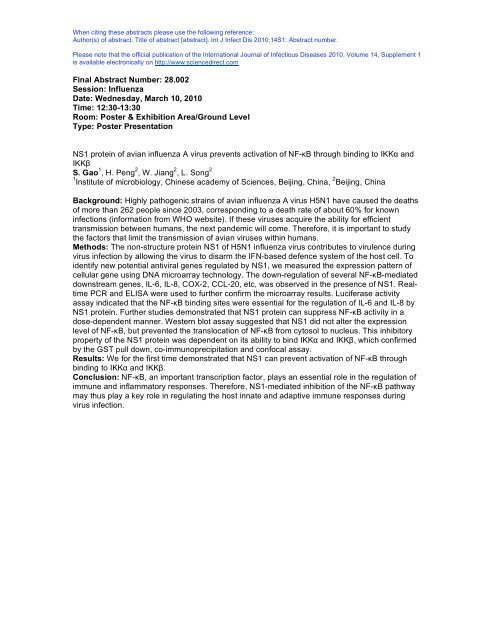14th ICID - Poster Abstracts - International Society for Infectious ...
14th ICID - Poster Abstracts - International Society for Infectious ...
14th ICID - Poster Abstracts - International Society for Infectious ...
You also want an ePaper? Increase the reach of your titles
YUMPU automatically turns print PDFs into web optimized ePapers that Google loves.
When citing these abstracts please use the following reference:<br />
Author(s) of abstract. Title of abstract [abstract]. Int J Infect Dis 2010;14S1: Abstract number.<br />
Please note that the official publication of the <strong>International</strong> Journal of <strong>Infectious</strong> Diseases 2010, Volume 14, Supplement 1<br />
is available electronically on http://www.sciencedirect.com<br />
Final Abstract Number: 28.002<br />
Session: Influenza<br />
Date: Wednesday, March 10, 2010<br />
Time: 12:30-13:30<br />
Room: <strong>Poster</strong> & Exhibition Area/Ground Level<br />
Type: <strong>Poster</strong> Presentation<br />
NS1 protein of avian influenza A virus prevents activation of NF-B through binding to IKK and<br />
IKK<br />
S. Gao 1 , H. Peng 2 , W. Jiang 2 , L. Song 2<br />
1 Institute of microbiology, Chinese academy of Sciences, Beijing, China, 2 Beijing, China<br />
Background: Highly pathogenic strains of avian influenza A virus H5N1 have caused the deaths<br />
of more than 262 people since 2003, corresponding to a death rate of about 60% <strong>for</strong> known<br />
infections (in<strong>for</strong>mation from WHO website). If these viruses acquire the ability <strong>for</strong> efficient<br />
transmission between humans, the next pandemic will come. There<strong>for</strong>e, it is important to study<br />
the factors that limit the transmission of avian viruses within humans.<br />
Methods: The non-structure protein NS1 of H5N1 influenza virus contributes to virulence during<br />
virus infection by allowing the virus to disarm the IFN-based defence system of the host cell. To<br />
identify new potential antiviral genes regulated by NS1, we measured the expression pattern of<br />
cellular gene using DNA microarray technology. The down-regulation of several NF-B-mediated<br />
downstream genes, IL-6, IL-8, COX-2, CCL-20, etc, was observed in the presence of NS1. Realtime<br />
PCR and ELISA were used to further confirm the microarray results. Luciferase activity<br />
assay indicated that the NF-B binding sites were essential <strong>for</strong> the regulation of IL-6 and IL-8 by<br />
NS1 protein. Further studies demonstrated that NS1 protein can suppress NF-B activity in a<br />
dose-dependent manner. Western blot assay suggested that NS1 did not alter the expression<br />
level of NF-B, but prevented the translocation of NF-B from cytosol to nucleus. This inhibitory<br />
property of the NS1 protein was dependent on its ability to bind IKK and IKK, which confirmed<br />
by the GST pull down, co-immunoprecipitation and confocal assay.<br />
Results: We <strong>for</strong> the first time demonstrated that NS1 can prevent activation of NF-B through<br />
binding to IKK and IKK.<br />
Conclusion: NF-B, an important transcription factor, plays an essential role in the regulation of<br />
immune and inflammatory responses. There<strong>for</strong>e, NS1-mediated inhibition of the NF-B pathway<br />
may thus play a key role in regulating the host innate and adaptive immune responses during<br />
virus infection.
















